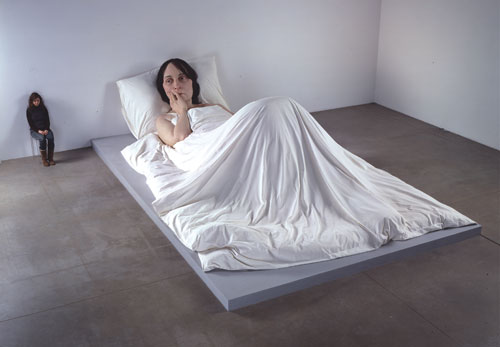 Winter 2007
Winter 2007|
“It ranges between pop and high art. If the sculptures share anything—elderly, middle age, baby—it’s the human condition.” -– Tom Sokolowski, director of The Warhol |
The giant In Bed is among the Mueck installations visitors will see at The Warhol in a show opening December 13.
Size Matters
In a new exhibition at The Warhol, Australian-born sculptor Ron Mueck plays with scale and intimacy, crafting wildly realistic recreations of the human figure.
His head rests on its fleshy cheek, eyes closed, wrinkles etched into his forehead. Traces of laugh lines are visible, and stubble dots his face and chin. Appropriately titled Mask II, Ron Mueck’s giant sculpted head sits on a pedestal, detached from a neck, shoulders, and body. It looks so real it tempts touch, leaving viewers wondering if it feels like flesh, too. There’s beauty and intimacy in Mueck’s sculptures for the simple reason that he captures people as they are, often at their most vulnerable: a giant baby covered in birth blood, a man crouched in a corner, naked. His very first sculpture, Dead Dad, is a miniature statute of his father crafted after his death. His dad lays like a corpse, in death the size of a child, naked, his closed eyes reddened, his hair graying. Mueck once said that while crafting the work, he began to care more about his father. Born to toymaker parents in Melbourne, Australia, Mueck moved to London, eventually joining Jim Henson studios. He crafted puppets for the popular children’s television series Fraggle Rock, honed his skills mastering special effects, and created a life-sized monster named Ludo, which he also voiced, for the movie Labyrinth. For 20 years he worked as a puppeteer, until his mother-in-law, well-known British painter Paula Rego, asked him to collaborate on a project for an art exhibit. Having never trained formally in the arts, he agreed, and following the collaboration he created Dead Dad. Since then, he’s crafted sculptures of humans in every stage of life. “I think Ron Mueck is fascinating. He’s been controversial. His work comes close to mannequins and dolls, it is going the way of Disney,” says Tom Sokolowski, director of The Andy Warhol Museum, which is hosting an exhibition of Mueck’s work through March of 2008. “What’s extraordinary is the immediacy,” he continues. “The craftsmanship is sublime.” Mueck, who rarely submits to interviews, told Sculpture magazine that he hoped people would look at his pieces of art and imagine that each has a life of its own. His careful attention to detail invites close-up inspection of blemishes, veins, a chipped fingernail, a bead of sweat, and the gamut of human emotions. The pensive woman In Bed could be a jilted lover or a mother worrying about a teenager. And while the title Spooning Couple might suggest two lovers lying in each other’s arms, a closer look reveals that the two simply lie beside one another. Both stonily gaze ahead. Perhaps they’re wishing they were someplace else or that life ended up differently. “Mueck’s work has sprezzatura,” says Sokolowski, “which means having the ability to make something look easy that is really hard. It ranges between pop and high art. If the sculptures share anything—elderly, middle age, baby—it’s the human condition.” To add a little spice to the realism, Mueck plays with scale, presenting both monumental and miniature works. He’s been quoted as saying that he finds the out-of-scale more interesting, since he sees average-sized people all the time. But some critics find the scale pointless. The New York Times’ Grace Glueck wrote, “Why so big? The subject has not earned its monumentality, so to speak, and its size distracts from its emotional intensity.” Sokolowski counters, “In a way, Mueck is asking us to have a willing sense of disbelief.” Visitors will find Mueck’s work displayed on several floors of The Warhol, partly because the large sculptures require the space, and partly because Mueck’s sculptures lend themselves to placement near other art—as if they, too, enjoy looking at what hangs on the gallery walls. |
Walking with the Dinosaurs · Tales from the Supporting Cast · From Trophies to Treasures · The Popular Salon of the People: Then and Now · Director's Note · NewsWorthy · Now Showing · Face Time: Diplodocus carnegii · About Town: International Appeal · First Person: It takes a village to raise a dinosaur · Science & Nature: Bodies of Knowledge · Another Look: Neapolitan Presepio Celebrates
 |
Copyright © 2017 CARNEGIE Magazine. All rights reserved. |

